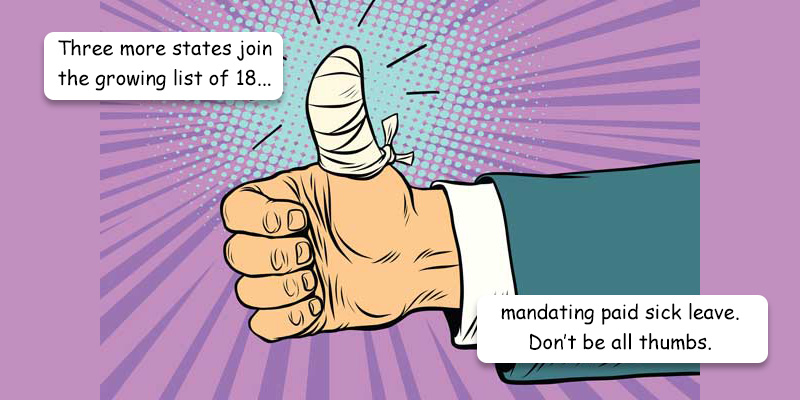Cyber crimes continue to rise, and big companies are no longer the sole target. The FBI recently issued their 2024 annual report on internet crimes and there were 859,532 complaints filed, totaling $16.6 billion in losses last year. That represents a 33% increase in losses, compared to 2023. The average loss is $19,372, and those numbers only represent what has been reported to the FBI. The actual loss is estimated to be much greater, as most losses go unreported. Fortunately, there are ways to protect your business from cyber criminals, like having secure networks and training your staff to look…
Posts published in “Uncategorized”
Currently, there is no federal law guaranteeing even one day of paid sick leave to workers, with the exception of federal contractors and government employees. There is the Family Medical Leave Act, but that simply provides the ability to take unpaid job-protected leave for specified family and medical reasons. There was an attempt back in 2016, where President Obama called on Congress to pass the Health Families Act which would have expanded sick leave to all private-sector workers, but it did not pass the House. Since that time, states and localities have taken action to provide all workers, within their…
Compensatory time, or “comp time,” is an alternative to overtime pay where employees receive paid time off instead of extra wages for overtime hours worked. But, not so fast. While this may seem like a useful tool for managing labor costs and scheduling, its legality depends on the type of business and the classification of employees. Employers must understand the rules before offering comp time to avoid legal issues. The legality of comp time depends on whether an employer operates in the public or private sector: Public-Sector Employers: Under certain prescribed conditions, employees of state and local government agencies are…
Paid Time Off, including Sick, Vacation, and the like policies, are an essential employee benefit, allowing workers to take time off while still receiving compensation. Many employers also offer PTO cash-out options where employees can receive payment for unused leave. However, these policies must be carefully structured to avoid unintended tax consequences under the IRS constructive receipt doctrine. If improperly designed, a PTO cash-out policy could result in employees being taxed on income they never actually received. This article explains how constructive receipt applies to PTO payouts and outlines strategies employers can use to structure PTO policies in a tax-compliant…
Each year in January, the Taxpayer Advocate Service (TAS) presents its annual report to Congress, consisting of a summary of the ten most serious problems encountered by taxpayers each year. It may not be any surprise to those waiting for their Employee Retention Tax Credit (ERC) refund, but the most serious problems reported for this year are the IRS delays, inefficiencies and lack of transparency in their processing of these claims. Created in 1996 by Congress, the TAS is an independent organization within the IRS; their job is to ensure that every taxpayer is treated fairly under the Taxpayer Bill…
2024 is coming to an end and 2025 is right around the corner. That means W-2's, FUTA credit, minimum wage changes and more. This PayMaster webinar relay will show you the year end review and the preparation needed for 2025.
Over the next few weeks, as your employees start to receive their 2024 W-2 form, they will likely have questions as to what all those numbers mean. For example, it is not uncommon for a salaried employee who earns a salary of $50,000 per year question why their Box 1 Wages only reflects $45,000. Did they get underpaid? Probably not. If the employee contributes to a pension plan (aka 401(k)) or has pre-tax insurance deductions, then those amounts reduces the “taxable” wage, which is what appears in Box 1. Some employees may also wonder why their Federal Income Tax withheld…
Under the provisions of the American Federal Unemployment Tax Act (FUTA), a Federal tax is levied on employers covered by the Unemployment Insurance program at a current rate of 6.0% on wages up to $7,000 a year paid to a worker. The law, however, provides a credit against federal tax liability of up to 5.4% to employers who pay state taxes timely under an approved state UI program. Accordingly, in states meeting the specified requirements, employers pay an effective Federal tax of 0.6%, or a maximum of $42 per covered worker, per year. The credit against the Federal tax may…
While the Federal minimum wage remains at $7.25 per hour for the past 16 years, 27 states and many cities, counties and locals have set increases effective January 1st, 2025 with a few announcing a change during 2025. Many states are continuing their march to $15.00 per hour with many states now exceeding that rate with places in Washington state that have a minimum wage above $20 per hour. A list of each state/local, along with the new hourly rate is listed below. States that do not have a minimum wage change scheduled may not be listed. All rates are…










